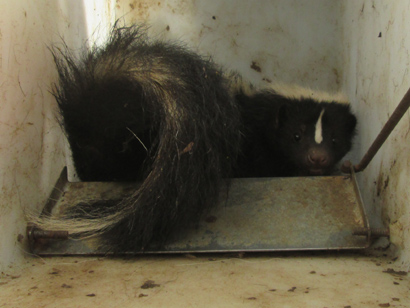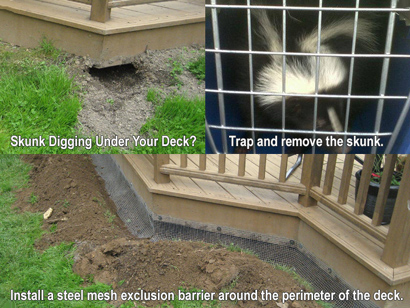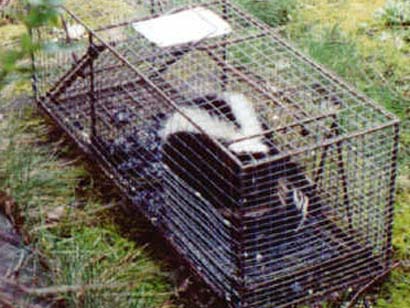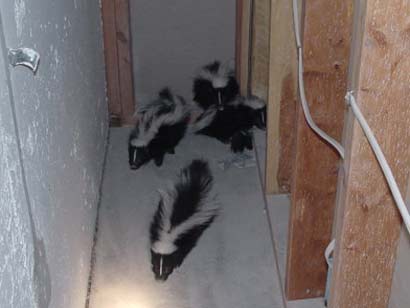- Skunk Removal - Information about the humane trapping and removal of skunks.
Skunk Removal
COMMON PROBLEMS: Skunks are common in suburban areas throughout most of the United States. They generally live wherever they please, without a great deal of caution. They like to live in dens when possible, especially in colder weather, when they will huddle together. Female skunks, of course, want a safe place to raise young, and are protective of the young, and will spray for protection. Thus, skunks cause some of the following problems:
- Living under human dwelling such as a deck, porch, or shed.
- Spraying and causing an odor in the immediate vicinity.
- Threatening or spraying a pet, usually a dog.
- Digging holes throughout the yard, in search of grubs.
- Damage to golf courses, crops, chicken coups, bee hives, etc.
- Individual skunk fell down a window well, and is stuck.
SKUNK UNDER A SHED OR PORCH: This almost always involves an adult female and a litter of baby skunks. The nest of baby skunks must be found & removed, & the mother trapped. Here are the general steps for removing skunks from under a deck, porch, or shed..
- Step 1: Inspect the structure, and find the entry hole(s), which are usually obvious - often of course, the whole structure is open around the perimeter.
- Step 2: Rather than simply set traps, the best option is to install an exclusion barrier, such as steel screen, around the entire perimeter, while leaving just one opening open.
- Step 3: Install a one-way exclusion door on the opening, or the proper sized cage traps.
- Step 4: Be sure the baby skunks are able to exit. If not, if they are too small, they must be removed by hand.
- Step 5: Relocate the whole family together, at least 10 miles from capture site.
- Step 6: Once all the skunks are out, seal the last open area shut.
- Step 7: Clean the area, removing all feces, and spray with enzyme cleaner.
GENERAL SKUNK TRAPPING: Skunk trapping is subject to state laws regarding capture and relocation or euthanization of wildlife. If you have unwanted skunks outside the home, in some cases, the only fix is to trap and remove the nuisance wildlife. We can safely, legally, and effectively catch and remove your nuisance skunks. Trapping is an art, and most amateur attempts go awry for a variety of reasons. An intimate knowledge of skunk behavior, both prior to and after trapping, and of various skunk trap types is necessary to ensure that the skunk is trapped and removed without incident.
- STEP 1: Determine if trapping is necessary, or if there is a preventative alternative.
- STEP 2: Select the right trap for the situation, of at least a dozen types of skunk traps.
- STEP 3: Set the traps in the correct areas, in the shade, camouflaged, on a flat sturdy surface, away from any obstructions or areas that can be damaged, etc.
- STEP 4: Use the correct bait. Don't use meat-based baits, which can attract stray cats.
- STEP 5: Monitor the trap daily, remove trapped skunks (carefully!) and transport them.
DEODORIZATION & OTHER SERVICES: Skunk odor is very hard to get rid of. We can fog any affected area with a special enzyme-based cleaner that destroys any organic matter and deodorizes the space, but it is not a 100% solution. A pet or clothing can be treated with the following method:
- 1 quart 3 percent hydrogen peroxide
- 1/4 cup baking soda (sodium bicarbonate)
- 1 teaspoon liquid soap or dish detergent
- Mix these together, and be sure to use it immediately, as this mix is unstable.
- Bathe or shampoo the dog/cloth thoroughly.
- Let sit for five minutes and rinse with tap water afterward, and repeat if necessary.
- For spray in the eyes, flush with water as soon as possible.
- This is your best bet. Stuff like tomato juice, vinegar, perfume, doesn't work very well.
Learn more about skunks through my educational articles. I have years of experience that can help you when dealing with these critters. Find out if a high pitch sound deterrent machine works against skunks, and how to get a skunk out of a window well. We can give advice about ways to kill a skunk in the yard, where you should relocate a trapped skunk, as well as how to keep skunks out of your Garbage Can. You can even find out if skunks swim. Some of our most sought-after advice is about skunk’s famous defense - learn whether or not a skunk will warn before spraying, and, if it’s already too late, How to Remove Skunk Spray.
How To Get Rid of Skunk - Tips and steps for getting rid of skunks.
How To Trap a Skunk - Methods for catching skunk in cage traps.
How to Kill a Skunk - Does poison work to kill skunk? Is killing skunk the best approach?
Skunk Feces - Pictures of skunk poop and info about danger, and diseases from skunk droppings.
Skunk Prevention - Preventative methods for how to keep skunk away from your property.
Skunk Repellent - Analysis of various skunk deterrents and repellent products.
What Bait Catches Skunk - What kind of food do you put in a trap to catch a skunk?
Skunk Under a Shed or Deck - Sometimes skunk will dig under or live under a shed or deck.
Diseases from Skunk - Analysis of what kinds of diseases skunk can carry and cause in humans.
Why do skunks spray? - Learn about this defense mechanism.
Do baby or juvenile skunks spray? - Yes they do!
About skunks - Biology, diet, etc.
Do skunks attack pets? - Sure! They spray them!
Should I feed a baby skunk I found?
Baby skunk removal - A nest of babies under the shed.
Do skunks burrow underground? - They dig, but don't burrow.
Do skunks attack chickens? - Rarely.
City/County Skunk Removal? Not Likely. - The county won't help for free.
Do skunks climb trees or fences? - They can't really climb well.
Damage Skunks Cause under a House - Odor problems, mostly.
Do skunks come out during the day? - Sometimes. May not be rabid.
Find out if it is legal for you to trap a skunk, and what to do if a skunk gets inside your house. Learn some humane ways to kill a skunk in a cage and if it is safe to handle a skunk with bare hands. I can show you how to keep skunks out of your Garden and how to Exclude Skunks without Trapping Them. Learn if skunks fight each other or if skunk feces are dangerous to touch or breathe. Find out what you should do with a skunk after you catch it and what equipment is needed to trap a skunk. Read about the Diseases Skunks Carry, why skunks Dig, and all about their natural diet. I can show you how to Find and Remove a Dead Skunk and let you know if a skunk under a shed or porch will have a nest of babies.
Learn about how aggressive skunks can be, as well as the symptoms of a Sick Skunk. Find out if skunks shed their fur or run out of spray, and let me show you how to get skunks out from under a shed or porch. Read about what wildlife rehabilitators do with skunks and if all skunks actually have rabies. Read more about whether a skunk that is active during the daytime at a higher risk of being rabid, and how to Protect Yourself from a Spraying Skunk. I can teach you the signs to look out for to know if you have a skunk under your shed or porch, and what to do if you find an orphaned baby skunk?. Read my thoughts on if you should ever poison a skunk and if skunks make good pets. I can even let you know if a Pest Control Company will remove a skunk.
Learn what to do if you find a nest of baby skunks and if mothballs or ammonia actually help repel skunks. Read more about Skunk Mating Habits and where skunks Live. I can even give advice on whether you should remove Skunks yourself.
Common North American Skunk Biology and Information
Most skunks are feared, not because they are vicious, but because their defense mechanism is offensive, not only to humans but also to most animals. The Skunk, sometimes called a polecat, is a Mephitidae species mammal that is found throughout the United States and Canada.
Biology - Skunks eat both plants and animals, which means that they are considered omnivorous. Their diets actually change with the seasons, during the spring; skunks will eat mice, grubs, snakes, and eggs. During the summer months their diet changes to beetles, crickets, and other insects, and during the winter they will consume rabbits, mice, and other little mammals. The skunk also loves fruits when they are available. There are several kinds of skunks, but the two common species are the stripped and the spotted. Both are black and white and have distinctive markings, with the stripped skunk being larger and weighing up to ten pounds. The spotted skunk is smaller and can weigh up the six pounds.
Life Cycle and Reproduction - Most skunks do not live past ten years, and in the wild this can drop to about three years. This mammal does not have many predators because of the foul smelling spray that they emit, although there are a few predatory birds, such as the owl, that will swoop down and take them. The skunk likes to live by themselves except when they are breeding or in the dead of winter when it is cold. They mate in the early spring with a polygynous male or one who breeds with several females and then the female will set up her den alone for birthing. The female will have a litter of about 4 to 6 babies, and are generally called kits. In May approximately sixty-two to sixty-six days after mating, the female will have her litter. The kits are small and covered in a fine fur and cannot see or hear. After about two months the babies will be weaned from the mother, but will stay with her through the summer before heading out on their own. All kits are striped even at birth and they have a natural instinct to spray as soon as they are weaned. The mothers are very protective their young and will spray if approached.
Habitat - Skunks do not hibernate in the winter, but they do sleep for long periods during the colder months. It is not unusual for several females to sleep together in a den, with the males living alone. These mammals do not see well and will stay within a certain area of about one and half miles for females, and up to five miles for the males. Skunks usually come out in the early mornings and late evenings to hunt, and will sleep during the day in burrows that they borrowed from other animals. The skunks will also live in hollow trees or abandoned vehicles if available.
Common Diseases These Animals Can Spread - The skunk can be a carrier of some very harmful diseases to humans as well as to pets. Since these mammals are adaptable to the urban areas they will live near humans especially if there is housing and water available so disease from these animals is possible. Skunks do carry rabies, as well as distemper and tularemia. Tularemia can cause pneumonia. The skunks also will carry many parasites such as ticks, lice, and worms.
Common Nuisance Complaints - One of the main complaints about skunks is the odor they produce when they feel threatened. This spray can be aimed at a predator from any direction, the back or the front and is very hard to get rid of once it has landed on pets or clothes. Most skunks will try to scare off what is bothersome by stamping and hissing, but if this does not work they will spray as a last resort and can reach up to ten feet accurately.





